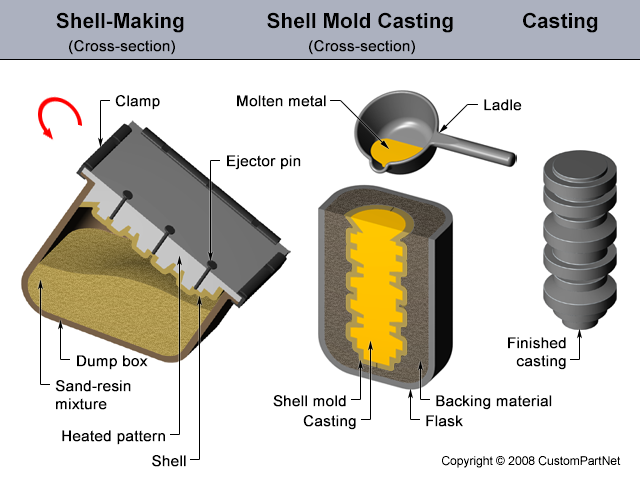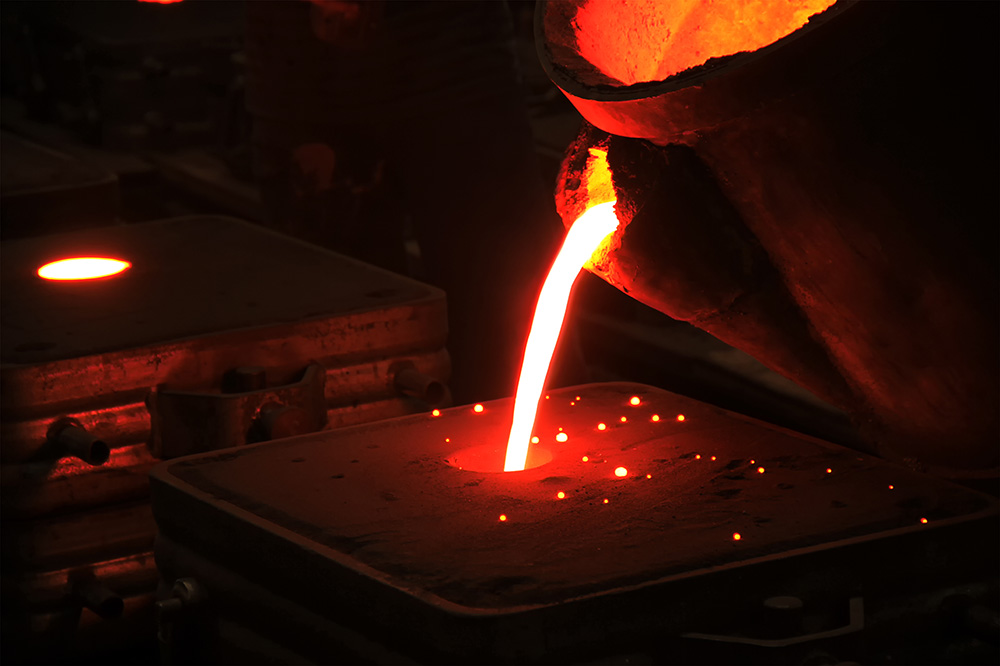Metal Castings and their critical importance in today’s global industries
Wiki Article
Understanding the Steel Castings Process: A Comprehensive Overview for Beginners
The Metal Casting procedure is a basic method in producing that transforms molten steel right into solid kinds. Newbies have to realize the numerous methods entailed, such as sand casting and pass away spreading. Comprehending the materials, design concepts, and safety and security procedures is similarly crucial. Each element plays an important function in accomplishing successful results. As one navigates these details, the question of how to optimize each step for enhanced results comes to be progressively important.The Fundamentals of Metal Casting
Although Metal Casting has progressed over centuries, its essential concepts continue to be consistent and integral to the manufacturing procedure. At its core, Metal Casting includes the transformation of liquified steel into strong objects with numerous strategies. The procedure begins with the creation of a mold and mildew, which defines the shape of the end product. When the mold is prepared, steel is heated up to its melting factor and poured right into the cavity. After cooling, the metal strengthens, taking the form of the mold and mildew.There are numerous casting approaches, consisting of sand spreading, financial investment casting, and pass away casting, each with distinct advantages and applications. The choice of technique relies on elements such as production volume, product type, and wanted accuracy. As soon as cast, the final item might undergo extra procedures like machining or surface area treatment to accomplish the needed surface and specifications. Recognizing these essentials is crucial for any individual curious about the field of Metal Casting.

Comprehending Materials Utilized in Metal Casting
Materials play a crucial role in the Metal Casting process, affecting the last product's residential or commercial properties and performance. Various steels are utilized, consisting of light weight aluminum, steel, bronze, and iron, each offering distinctive qualities fit for particular applications. Light weight aluminum is corrosion-resistant and lightweight, making it perfect for automobile components. Iron, specifically cast iron, is preferred for its outstanding wear resistance and resilience. Steel provides high stamina and flexibility, usually used in heavy machinery parts. Bronze, recognized for its deterioration resistance and machinability, is typically used in aquatic applications.Along with the metals, numerous casting materials, such as sand, plaster, and ceramic, are used to produce molds. Sand casting, the most common approach, makes use of silica sand as a result of its thermal stability and capacity to form elaborate shapes. Plaster and ceramic molds supply finer details however may require even more complex procedures. The choice of products straight affects the performance, expense, and quality of the casting operation.
The Layout Refine: From Idea to Blueprint
The style procedure in Metal Casting starts with the preliminary idea advancement, where ideas are generated and reviewed. This is adhered to by the application of CAD modeling techniques, enabling for accurate visualizations of the layout. The plan finalization actions ensure that all specs are accurately recorded for production.Initial Idea Advancement
Initial concept development notes a vital stage in the Metal Casting process, where ideas change into tangible styles. During this stage, developers work together with stakeholders and engineers to brainstorm and refine first principles. They think about variables such as capability, aesthetic appeals, and manufacturability, making certain that the style fulfills the called for specifications and performance criteria. Sketches and outlines are produced to picture the ideas, allowing for initial assessments of usefulness and cost-effectiveness. This stage likewise includes determining products and prospective spreading approaches that align with the layout objectives. Eventually, first idea growth prepares for a detailed plan, assisting the succeeding stages of the spreading process and guaranteeing an effective change from idea to reality.CAD Modeling Techniques
Transforming concepts right into specific styles, CAD modeling methods play a critical function in the Metal Casting procedure. These methods use innovative software to create in-depth three-dimensional versions that accurately show the intended product. By using tools such as parametric modeling, solid modeling, and surface modeling, developers can control dimensions and shapes effortlessly. CAD systems likewise assist in simulation and evaluation, permitting the recognition of potential imperfections prior to manufacturing starts. This proactive technique minimizes material waste and maximizes the design Aluminum Foundry for manufacturability. Additionally, CAD designs can be easily customized, allowing quick versions based on comments. Essentially, CAD modeling acts as the backbone of the design procedure, bridging the void between initial ideas and the ultimate production-ready layouts.Blueprint Completion Steps
Complying with the creation of comprehensive CAD versions, the next phase includes plan completion, which is essential in translating electronic styles into actionable prepare for manufacturing. This process begins with evaluating the CAD versions for accuracy and conformity with specifications. As soon as confirmed, the measurements, tolerances, and product specs are thoroughly outlined to ensure clarity. Incorporating notes and notes aids communicate crucial details concerning casting procedures, surface area coatings, and assembly requirements. The completed plan undertakes a strenuous authorization procedure, often entailing cooperation with designers and production groups to address any type of possible issues. Alterations are made and authorizations obtained, the plan is formally launched, serving as the foundational record for the subsequent stages of Metal Casting, consisting of pattern production and mold and mildew design.The Metal Casting Strategies Explained

Metal Casting methods incorporate a selection of methods used to form molten metal right into wanted forms. These techniques differ according to the kind of material, complexity of the layout, and production quantity. Sand spreading is one of one of the most common approaches, including the production of a mold from sand to hold the molten metal. Financial investment casting, or lost-wax casting, permits for intricate styles by using a wax pattern that is disappeared. Pass away casting uses high-pressure shot of liquified metal into a mold, ideal for automation. Other methods consist of irreversible mold and mildew spreading, which uses recyclable mold and mildews, and centrifugal casting, where rotational pressures help in filling up the mold. Each method has its applications and benefits, making it essential for makers to pick the appropriate technique based upon their details demands and demands. Understanding these techniques is necessary for anyone associated with the Metal Casting process.
Ending Up Procedures: Enhancing Your Casted Product

Completing processes play an essential role in improving the top quality and look of casted products. Different surface area treatment techniques, such as sprucing up and layer, are employed to improve durability and visual appeals. Furthermore, top quality inspection techniques assure that the final product satisfies specified criteria and efficiency demands.
Surface Area Therapy Strategies
A range of surface therapy techniques play a vital duty in improving the quality and longevity of casted items. These strategies consist of approaches such as shot blasting, polishing, and finishing. Shot blasting effectively eliminates surface blemishes, boosting the practical and visual characteristics of the casting. Polishing offers a smooth coating, which is particularly vital for ornamental applications and parts requiring marginal friction. Covering strategies, such as electroplating or powder coating, deal additional security against deterioration and wear, making sure toughness. Furthermore, surface area treatments can enhance attachment for succeeding processes, such as paint or bonding. By employing these techniques, makers can attain premium surface quality, which is critical for the performance and life expectancy of Metal Casting in numerous applications.High Quality Evaluation Approaches
Efficient quality evaluation methods are important for assuring the integrity and efficiency of casted items after the finishing procedures. Different techniques are employed to evaluate the quality of Metal Casting, including aesthetic assessment, dimensional checks, and non-destructive screening (NDT) Visual inspection enables the recognition of surface issues, while dimensional checks ensure that items fulfill defined resistances. NDT methods, such as ultrasonic testing and radiographic evaluation, provide deeper understandings into internal honesty without harming the castings. Additionally, mechanical screening, such as tensile and solidity examinations, evaluates product residential properties - Metal Castings. By using a combination of these techniques, producers can enhance item quality and integrity, inevitably resulting in better consumer satisfaction and reduced production pricesSafety Considerations in Metal Casting
While the Metal Casting procedure offers numerous benefits, it also presents a variety of safety and security threats that have to be carefully managed. Employees in casting facilities are exposed to high temperature levels, molten metals, and hazardous products, which can bring about severe injuries if appropriate safety measures are not taken. Personal safety devices (PPE) such as heat-resistant gloves, deal with shields, and safety garments is important to reduce threats.In addition, the presence of fumes and dirt requires proper ventilation systems to guarantee air quality - Metal Castings. Normal training on security protocols is crucial for all workers to acknowledge possible dangers and react properly. Emergency situation procedures must be developed, including fire precaution and initial aid schedule. Maintenance of tools and appropriate handling of materials additionally add to a much safer working atmosphere. By prioritizing these safety and security considerations, Metal Casting operations can protect their labor force and preserve reliable manufacturing procedures
Regularly Asked Questions
What Are the Ecological Impacts of Metal Casting?
Metal Casting can bring about environmental effects such as air and water contamination, source exhaustion, and energy intake. Additionally, incorrect waste monitoring and discharges from foundries add to environmental disruptions and health and wellness dangers for nearby communities.How Do I Choose the Right Steel for Spreading?
To pick the best steel for casting, one have to take into consideration elements such as mechanical homes, rust resistance, thermal conductivity, and cost. Assessing the desired application and environmental problems is important for excellent selection.What Are the Usual Issues in Metal Casting?
Typical problems in Metal Casting include porosity, contraction, sand inclusion, and misruns. These concerns commonly develop from inappropriate product selection, poor layout, or flaws in the casting process, impacting the end product's quality and efficiency.
Exactly How Can I Boost My Metal Casting Skills?
To enhance Metal Casting skills, one ought to practice constantly, study casting methods, examine previous projects for issues, look for comments from skilled casters, and constantly experiment with different products and techniques to improve proficiency and understanding.What Is the Price of Starting a Metal Casting Service?
Starting a metal casting business normally calls for an initial financial investment of $5,000 to $50,000, relying on equipment, products, and center expenses. Variables like area and scale can substantially influence general startup expenses.The Metal Casting procedure is a fundamental strategy in manufacturing that transforms molten steel into strong forms. Novices must grasp the numerous techniques involved, such as sand spreading and die spreading. There are numerous casting approaches, including sand casting, investment casting, and die spreading, each with distinct benefits and applications. Investment spreading, or lost-wax casting, enables for detailed styles by utilizing a wax pattern that is melted away. Various other techniques include long-term mold spreading, which utilizes reusable molds, and centrifugal spreading, where rotational pressures aid in loading the mold and mildew.
Report this wiki page